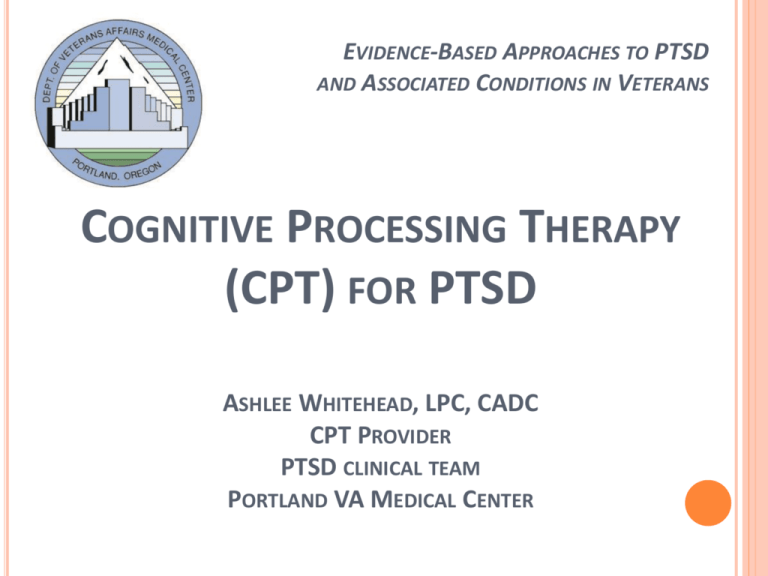Workshop: Cognitive Processing Therapy
advertisement

EVIDENCE-BASED APPROACHES TO PTSD AND ASSOCIATED CONDITIONS IN VETERANS COGNITIVE PROCESSING THERAPY (CPT) FOR PTSD ASHLEE WHITEHEAD, LPC, CADC CPT PROVIDER PTSD CLINICAL TEAM PORTLAND VA MEDICAL CENTER COGNITIVE PROCESSING THERAPY (CPT) FOR PTSD OVERVIEW OF TODAY’S PRESENTATION History of CPT Theory, Rationale & Goals The Essential Ingredients Structure CPT of CPT Resources COGNITIVE PROCESSING THERAPY (CPT) FOR PTSD ORIGINS OF CPT CPT is a cognitive therapy for PTSD Published by Resick & Schnicke(1993) Over 20 years of clinical practice, initially focused on trauma of rape. Resick, Monson & Chard expanded to fit veteran/military population (2006) 2006 - VA Office of Mental Health Services began CPT training roll-out to VA providers focused on military trauma. COGNITIVE PROCESSING THERAPY (CPT) FOR PTSD THEORY BEHIND CPT Based on Social Cognitive Theory Traumatic Events can dramatically alter basic beliefs about the world, the self and others. Focuses on how trauma survivors integrate traumatic events into their overall belief system through assimilation or accomodation Not incompatible with Information/ Emotional Processing Theories Expands the range of emotional responses that can be addressed in treatment. COGNITIVE PROCESSING THERAPY (CPT) FOR PTSD SOCIAL COGNITIVE THEORY OF TRAUMA 5 major dimensions that may be disrupted by traumatic events: 1) 2) 3) 4) 5) Safety Trust Power and Control Esteem Intimacy COGNITIVE PROCESSING THERAPY (CPT) FOR PTSD CPT RATIONALE PTSD symptoms are attributed to a "stalling out" in the natural process of recovery What interferes with natural recovery from PTSD? Avoidance Behaviors reinforce Distorted beliefs about the trauma and become Generalized to current life situations Cognitive-focused techniques are used to help patients move past stuck points and progress toward recovery. COGNITIVE PROCESSING THERAPY (CPT) FOR PTSD CPT GOALS Process natural emotions (other than fear) in clients with PTSD. Address the content of the meaning derived from the traumatic memory. Accomodation - accepting that the traumatic event occurred and discovering ways to successfully integrate the experience into the one’s life (e.g., “In spite of this bad event happening to me, I am a good person.”). Accommodation reflects balanced thinking. WHEN TO IMPLEMENT CPT AND PRE-TREATMENT ISSUES TO CONSIDER Recommended for clients with: PTSD and comorbid diagnoses (e.g., depression, anxiety, substance use, TBI) Not Recommended for clients with: Active suicidal behavior Current Psychosis No memory of the trauma event FROM ENGAGEMENT TO RETENTION MI techniques Client needs to believe that improvement is possible Client needs to believe that he has the ability to tolerate therapy (skills) Desire to approach outweighs desire to avoid Therapist adherence to protocol COGNITIVE PROCESSING THERAPY (CPT) FOR PTSD THE ESSENTIAL INGREDIANTS The Impact of the Event Identifying Stuck Points Identifying and resolving assimilated beliefs Challenging beliefs. Use and balancing overaccomodated of Socratic Questioning Processing trauma natural emotions related to the SO… WHAT ARE STUCK POINTS? THOUGHTS & INTERPRETATIONS ABOUT THE TRAUMATIC EVENT AUTOMATIC - DISTORTED - MAY OCCUR BENEATH ONE’S AWARENESS Thoughts not Feelings Black and White All or Nothing Thought behind the “golden rule” If/Then statements Not always “I statements” STUCK POINTS IN 5 DIMENSIONS SAFETY I cannot protect myself/others. The world is completely dangerous. TRUST Other people should not trust me. The government cannot be trusted. POWER/CONTROL I must control everything that happens to me. People in authority always abuse their power. ESTEEM I deserve to have bad things happen to me People are by nature evil and only out for themselves. INTIMACY I am unlovable because of the trauma. If I let other people get close to me, I'll get hurt again. PRACTICE ASSIGNMENT – THE IMPACT STATEMENT “Please write at least one page on why you think this traumatic event occurred. You are not being asked to write specifics about the traumatic event. Write about what you have been thinking about the cause of the worst event. Also, consider the effects this traumatic event has had on your beliefs about yourself, others, and the world in the following areas: safety, trust, power/control, esteem, and intimacy.” THE IMPACT STATEMENT – MST EXAMPLE “The overall feeling of what it means to have been assaulted is the feeling that I must be bad or a bad person for something like this to have occurred. I feel it will or could happen again at any time. I feel only safe at home. The world scares me and I think it unsafe. I feel all people are more powerful than I, and am scared by most people. I view myself as ugly and stupid. I can’t let people get real close to me. I have a hard time communicating with people of authority, so plainly I haven’t been able to work. I don’t trust others when they make promises. I find it hard to accept that these events have happened to me.” HOW TO GET “STUCK” Prior beliefs can be disrupted or reinforced by the trauma EXAMPLE: The Just World Belief “GOOD THINGS HAPPEN TO GOOD PEOPLE & BAD THINGS HAPPEN TO BAD PEOPLE” Innocent people were killed I was raped in the military NOW WHAT DO I BELIEVE????? ASSIMILATION Traumatic event is remembered differently to preserve original beliefs and assumptions 16 Original Belief Rape=Stranger Traumatic Event Raped by friend Assimilation Misunderstanding Modified memory of the traumatic event doesn’t fit with emotions experienced Creates disconnect between the memories and the emotions Undoing and Self-Blame OVER-ACCOMMODATION Overall 17 beliefs and assumptions about self and the world change too much following the traumatic event and are no longer accurate Original Belief People=Good Traumatic Event War Atrocities Over-accommodation People=Evil “I WAS RAPED IN THE MILITARY” Assimilate - It wasn’t really rape. - Because I didn’t fight harder, the rape is my fault. - I am worthless because I couldn’t control what happened. Accommodate - I wasn’t in a position where I could fight back at the time. - Some men can be trusted. - I have control over how to handle this. Overaccomodate - If I let other people get close to me, I'll get hurt again. - Men are dangerous and can’t be trusted. - I must control everything that happens to me. “INNOCENT PEOPLE WERE KILLED” Assimilate - I should have prevented it. - It was my fault. - I deserve to have bad things happen to me. - It didn’t really happen. Accommodate - Mistakes were made. - Although lives were lost, many lives were saved. - Sometimes bad things happen to good people. Overaccomodate - Government cannot be trusted. - Nowhere is safe (I must stay on guard at all times). - I am powerless. SOCRATIC QUESTIONING “IUsed to challenge stuckpoints don’t see the point in Helping not telling (the wisdom is asking allperson) these within the Guided discovery. could questions. Getting patientI to ask thehave questions themselves pointed out the flaws in Helping them become aware of the client’s thinking and inconsistencies changed ABC’s her mind much Ask more quickly by taking a Be on their team more direct Think Criticallyroute!” about their logic PROCESSING THE IMPACT STATEMENT “Now, let’s go back to the Impact Statement you wrote. What kinds of things did you write about when thinking about what it means to you that the assault happened to you? What feelings did you have as you wrote it?” COGNITIVE PROCESSING THERAPY (CPT) FOR PTSD CPT THERAPY HAS 4 MAIN PARTS Learning about PTSD symptoms Becoming aware of thoughts & feelings about the trauma Learning skills Understanding changes in beliefs COGNITIVE PROCESSING THERAPY (CPT) FOR PTSD STRUCTURE OF CPT SESSIONS Individual CPT Group CPT • 12 x 50-minute structured sessions • Participants complete outof-session practice assignments • Sessions typically conducted weekly or biweekly • Includes a brief written trauma account along with ongoing practice of cognitive techniques • 12 x 90-120 minute structured sessions • Participants complete outof-session practice assignments • Typically conducted by 2 clinicians • 8-10 Veterans per group • Includes a brief written trauma account component, along with ongoing practice of cognitive techniques THE INDIVIDUAL SESSIONS ARE: Session 1: Introduction and Education Session 2: The Meaning of the Event Session 3: Identification of Thoughts and Feelings Session 4: Remembering the Traumatic Event Session 5: Identification of Stuck Points Session 6: Challenging Questions Session 7: Patterns of Problematic Thinking Session 8: Safety Issues Session 9: Trust Issues Session 10: Power/Control Issues Session 11: Esteem Issues Session 12: Intimacy Issues and Meaning of the Event A-B-C Sheet Date: _________ Name: ________________ ACTIVATING EVENT A “Something happens” Let’s make the event: Coming here today BELIEF B “ I tell myself something” What thoughts did you have about coming to this presentation today? CONSEQUENCE C “I feel something” What emotions come up with those thoughts? Does it make sense to tell yourself “B” above? _____________________________________________________________________ ____________________________________________________________________________________________________________ What can you tell yourself on such occasions in the future? ___________________________________________________ ____________________________________________________________________________________________ A-B-C Sheet Date: _________ Name: ________________ ACTIVATING EVENT A “Something happens” No let’s change the event to: Using evidencebased therapies in PTSD BELIEF B “ I tell myself something” What thoughts do you have about using EBTs? CONSEQUENCE C “I feel something” What emotions come up with those thoughts? Does it make sense to tell yourself “B” above? _____________________________________________________________________ ____________________________________________________________________________________________________________ What can you tell yourself on such occasions in the future? ___________________________________________________ ____________________________________________________________________________________________ A PROMOTIONAL VIDEO HOW TO REFER A CLIENT TO CPT Cognitive Processing Therapy is available through VA Medical Centers, including through the Portland VAMC PTSD Clinical Team (PCT) for eligible veterans. Portland VA Medical Center http://www.portland.va.gov/ Eligibility/Enrollment (503) 220-8262, ext. 55289 Admission to the PCT requires a consult from the veteran's Mental Health Provider at the Portland VA Medical Center. If the veteran does not have a Mental Health Provider, the first step would be to call the Mental Health Access Clinic at 503-220-8262 x56479. A screening interview will be required as a condition of admission. ADDITIONAL RESOURCES An online CPT review course is available through the Medical University of South Carolina at https://cpt.musc.edu/index National Center for PTSD http://www.ptsd.va.gov/ Cognitive Therapy for Posttraumatic Stress Disorder by Shipherd, Street, and Resick in Chapter 5 of CognitiveBehavioral Therapies for Trauma, Second Edition by Victoria M. Follette PhD and Josef I. Ruzek (2007)


